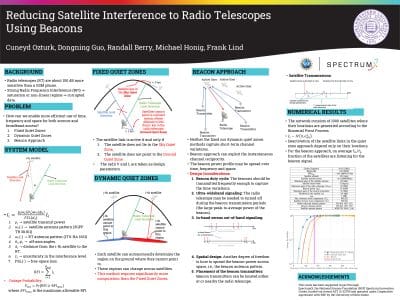Authors
Cuneyd Ozturk, Dongning Guo, Randall Berry, Michael Honig, Frank Lind
Abstract
This paper proposes the transmission of beacon signals to alert potential interferers of an ongoing or impending passive sensing measurement. We focus on the interference from Low-Earth Orbiting (LEO) satellites to a radio-telescope. We compare the beacon approach with two versions of Radio Quiet Zones (RQZs): fixed quiet zones on the ground and in the sky, and dynamic quiet zones that vary across satellites. The beacon-assisted approach can potentially exploit channel reciprocity, which accounts for short-term channel variations between the satellite and radio telescope.
System considerations associated with beacon design and potential schemes for beacon transmission are discussed. The probability of excessive Radio Frequency Interference (RFI) at the radio telescope (outage probability) and the fraction of active links in the satellite network are used as performance metrics. Numerical simulations compare the performance of the approaches considered, and show that the beacon approach enables more active satellite links relative to quiet zones for a given outage probability.

